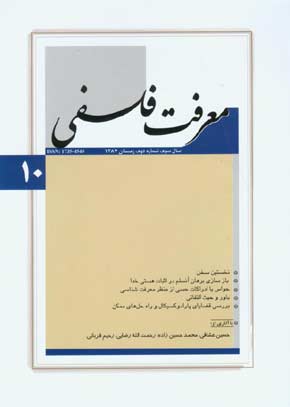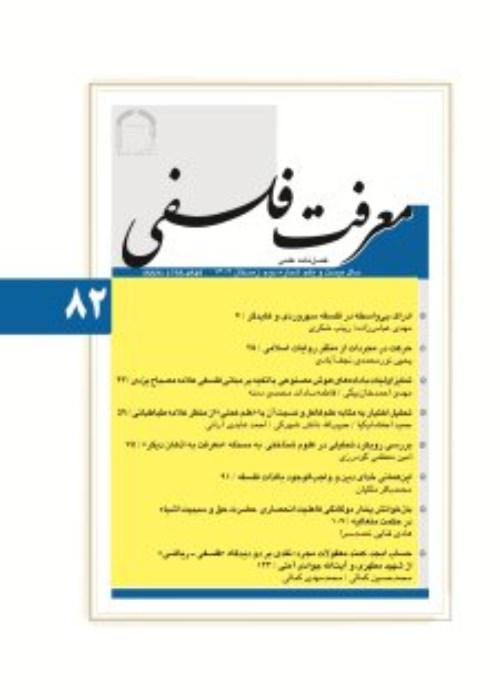فهرست مطالب

فصلنامه معرفت فلسفی
سال سوم شماره 2 (پیاپی 10، زمستان 1384)
- 148 صفحه، بهای روی جلد: 6,000ريال
- تاریخ انتشار: 1385/03/31
- تعداد عناوین: 6
-
صفحه 7
-
صفحه 11یکی از جنجالیترین برهانهای اثبات خدا، برهان آنسلم است که بر پایه مفهوم «وجود برترین» شکل گرفته. این برهان در حقیقت، از مفهوم «وجود برترین» به واقعیت آن پلی زده است. از همان ابتدای طرح (قرن 11 میلادی) تاکنون، این برهان با نقض و ابرامهایی همراه بوده است؛ از جمله، دکارت آن را تایید و کانت و راسل آن را رد کردهاند. در بین فیلسوفان اسلامی نیز شهید مطهری و آی هالله جوادی آملی نقدهایی بر این برهان ارائه نمودهاند.
این مقاله با بازسازی اصل برهان به حل همه اشکالات مربوط به این برهان میپردازد.
کلیدواژگان: برهان آنسلم، وجود برترین، معدوم، متحد المصداق، موجود -
صفحه 29ادراک حسی از منظرهای گوناگون قابل بحث و بررسی است. در این نوشتار، پس از نگاهی گذرا به جایگاه «ادراک حسی» در دانشهای گوناگون، مهمترین مباحثی که میتوان از منظر معرفتشناسی درباره ادراک حسی و حواس ظاهری ارائه کرد، طرح و بررسی شده است. در میان این مباحث، مسائلی همچون حضوری یا حصولی بودن ادراک حسی، نحوه حکایتگری مفاهیم حسی، امکان شناخت ذاتیات و ماهیات اشیای خارجی و اعتبار ادراک حسی از همه برجستهتر است.
به نظر میرسد در حالی که معرفت به احساس یعنی نفس تاثرات مادی از راه علم حضوری تحقق می یابد، ادراک حسی معرفتی حصولی بوده، مفید مفهوم و تصور است، نه قضیه و تصدیق.
از یکسو، با حس و عقل نمیتوان به کنه اشیا و فصلهای حقیقی آنها دست یافت و از سوی دیگر، ادراک حسی خطاناپذیر بوده، خطاهایی که در مورد آن تصور می شود به احکام و تفسیرهای عقل ارجاع می یابد.
کلیدواژگان: ادراک حسی، احساس، مفهوم، قضیه، ذاتیات اشیا، خطاناپذیری ادراک حسی، حکایتگری تصویری، عینیت گرایی، چگونگی پیدایش خطا -
صفحه 75در مورد «باور» چند پرسش مهم مطرح است: نخست اینکه «باور» چیست و آیا اصولا چیزی به نام «باور» وجود دارد یا نه؟ دوم اینکه باور دارای چه ویژگی هایی است؟ سوم اینکه باور و معرفت چه نسبتی با هم دارند؟ و سرانجام اینکه منظور از «باور» چیست؟
در پاسخ به پرسش نخست، دو دیدگاه مهم مطرح است: رفتارگرایی و کارکردگرایی. هرچند این دو مباحثی متافیزیکی هستند، اما چالش های معرفتی مهمی به وجود میآورند. مهمترین ویژگی «باور»، حیث التفاتی آن است که پیشینه آن به ابن سینا باز میگردد. این بحث را، که بعدآ برنتانو احیا نمود، امروزه در فلسفه های تحلیلی و «فلسفه» ذهن مورد توجه جدی قرار گرفته است.
در باب نسبت میان «باور» و «معرفت»، دستکم چهار دیدگاه مهم مطرح است که عبارتند از: انکار وجود چیزی به نام «باور» (دیدگاه رفتارگرایان)، نفی تلازم میان باور و معرفت، جداانگاری ساحتهای باور، و معرفت و تلازم آن دو.
کلیدواژگان: باور، حذف گرایی، کارکرد گرایی، حیث التفاتی، آگاهی، معنا، فهم، صدق و معرفت -
صفحه 111مسئله «ناسازگاری درونی گزاره ها» از روزگار باستان، مورد توجه اندیشمندان و دانشمندان بوده است. برخی آن را شبهه و مغالطه، برخی ناسازگاری بنیادی علم و ریاضی، برخی مسئله زبانشناسی و برخی به عنوان مسئلهای وجودی و عینی تلقی کردهاند و هر کدام برای حل و تبیین آن، تلاشهایی به انجام رساندهاند. نوشتار حاضر به بررسی و نقد اجمالی این تلاشها میپردازد. در این بررسی، سه دسته از راهحلهای ارائه شده مطرح میشود: 1. راهحلهای فلسفی؛ 2. راهحلهای منطقی؛ 3. راهحلهای فرافلسفی و فرامنطقی. در ذیل هر یک از این راهحلها، نظراتی مورد بررسی واقع شده است.
کلیدواژگان: قضایای پارادوکسیکال، گزاره خودشکن، نماد ریاضی و منطقی، عینیت نفس الامری، فهم عرف، مسئله زبان، نگرش فازی
-
Page 7
-
Page 11Anselm’s argument is one of the most debated arguments for the existence of God. It is based on the notion of “the Supreme Being”, bridging it to its reality. This argument, however, has had its ambiguity and its pros and cons. For instance, Descartes affirmed it while Kant and Russell rejected it. From among Muslim philosophers, Shahīd Mutahari and Ayatullāh Javādi Āmuli have criticized this argument. This article tries to restructure the argument in a way that it can answer all criticisms.
-
Page 29Sense perception can be studied from different perspectives. Reviewing the place of sense perception in various disciplines, the author suggests some of the most important issues in this regard that can be investigated from an epistemological point of view. He considers most notable from among them problems such as whether sense perception is a kind of knowledge by presence or a type of knowledge by representation, the way sense concepts refer to their referents, the possibility of understanding essentials and the nature of objects, and the reliability of sense perception.It seems that our knowledge of sense perception—namely, corporal reaction itself—is born by way of knowledge by presence, while sense perception is a knowledge by representation, leading to a notion and idea, not to a proposition and affirmation. On the one hand, one cannot reach the depth and real differentia of things through senses nor through reason, and on the other, sense perception is unerring. Possible errors are the result of rational judgments and interpretations about them.
-
Page 75There are at least four main theories about the relation of belief to knowledge:First is the idea of inconsistency of belief and knowledge, which was first proposed by Plato. Second is the idea of their correspondence which was suggested by such philosophers as Ayer, with which some Muslim logicians and philosophers have sympathized. Third is the separability of belief and knowledge and their different spheres, put forward by Colin Radford. And finally, is the theory supported by behaviorism, and called “eliminativism”. One of the consequences of these viewpoints is their different interpretations of the most important facet of belief, namely, “intentional aspect”, the history of which goes back to Ibn-Sīnā. This article is an attempt to explore these points of view. In the first part, the metaphysical issues about belief are discussed, and in the second part, epistemological aspect is studied. The author favors the idea that “understanding” is what can constitute knowledge.
-
Page 111The problem of “the internal inconsistency of propositions” has caught the attention of philosophers and thinkers from the early days. Some of them have considered it as a fallacy, others as a fundamental incoherence between science and mathematics. Still some have called it a linguistic problem, and others thought about it as an ontological and objective issue. Each and every group has also tried to explain and solve this problem. This paper is an effort to study and briefly scrutinize different approaches. In this study, three solutions are examined: a) philosophical solutions, b) logical solutions, and c) meta-philosophical and meta-logical solutions. It looks into different ideas proposed under each solution as well.
-
ABSTRACTSPage 4


